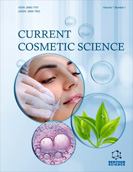Abstract
Background and Objective: Glabridin (Glab) is a polyphenolic flavonoid of licorice acclaimed for its skin whitening properties. However, its poor solubility, low physicochemical stability and inefficient percutaneous penetration create hurdles in the best use of this agent in dermocosmetic application. The purpose of the present work was to prepare and evaluate Glabridinloaded nanostructured lipid carrier (Glab NLC) in order to enhance its skin permeation, and hence, promote its skin-whitening potential in cosmetic formulations. Nanostructured lipid carrier (NLC) has already proven its potential for drug delivery via the skin by offering various benefits, like high tolerability, biocompatibility, high drug loading, improved stability, and close contact with stratum corneum, leading to rich skin penetration and protection of bioactive from degradation.
Methods: NLC was prepared by solvent emulsification diffusion technique and was evaluated for particle size, zeta potential, polydispersity index, drug loading and encapsulation, and in vitro drug release. Optimized formulation was incorporated into a cream base, and its skin whitening activity was evaluated. Glycerol monostearate (GMS) and olive oil were chosen as solid and liquid lipids for NLC formulation.
Results: The particle size, PDI, zeta potential, entrapment efficiency, and drug release of optimized formulation were found to be 189 nm, 0.259, -14.5mV, 94.56 %, and 98.86 ± 0.80 %, respectively. The optimized NLC was incorporated into a suitable cream base and evaluated. The skin whitening activity of Glabridin NLC cream was determined by performing tyrosinase inhibition activity. The percentage inhibition value of GlabNLC loaded cream and Kojic acid against mushroom tyrosinase was found to be 60.31% and 52.61%, respectively.
Conclusion: The obtained results advocate lipid particles as an appropriate carrier of Glabridin for skin whitening cosmetic cream.
Keywords: Glabridin, nanostructured lipid carrier, cream, skin whitening, tyrosinase inhibition, melanin, mushroom tyrosinase.
Graphical Abstract
[http://dx.doi.org/10.1016/j.ejps.2016.08.030] [PMID: 27543066]
[http://dx.doi.org/10.1517/17425247.2012.666967] [PMID: 22394125]
[http://dx.doi.org/10.1007/978-3-319-10711-0_2]
[http://dx.doi.org/10.1016/j.ijpharm.2007.05.061] [PMID: 17644288]
[http://dx.doi.org/10.1111/j.1468-2494.2008.00433.x] [PMID: 18452432]
[PMID: 11567210]
[http://dx.doi.org/10.1016/j.ijpharm.2008.10.003] [PMID: 18992314]
[http://dx.doi.org/10.1016/j.fitote.2013.07.003] [PMID: 23850540]
[PMID: 27348968]
[http://dx.doi.org/10.1016/B978-0-7020-6056-4.00085-X]
[http://dx.doi.org/10.1016/j.ijpharm.2019.02.028] [PMID: 30836152]
[http://dx.doi.org/10.1177/1934578X1000501214] [PMID: 21299118]
[http://dx.doi.org/10.1007/s13765-012-2001-0]
[http://dx.doi.org/10.1016/j.apsb.2014.10.005] [PMID: 26579417]
[http://dx.doi.org/10.1080/10717544.2018.1529209] [PMID: 30451015]
[http://dx.doi.org/10.1016/S0378-5173(03)00135-2]
[http://dx.doi.org/10.1089/adt.2020.1070] [PMID: 33781090]
[http://dx.doi.org/10.20510/ukjpb/3/i3/89410]
[http://dx.doi.org/10.7241/ourd.20141.02]
[http://dx.doi.org/10.22159/ijpps.2018v10i11.28645]
[http://dx.doi.org/10.1016/j.saa.2016.06.008] [PMID: 27288962]
[http://dx.doi.org/10.1248/cpb.50.450] [PMID: 11963989]
[http://dx.doi.org/10.1016/j.bfopcu.2015.10.001]
[http://dx.doi.org/10.1208/s12249-011-9727-6] [PMID: 22167415]
[http://dx.doi.org/10.1016/j.jcis.2017.07.008] [PMID: 28697547]
[http://dx.doi.org/10.1088/0957-4484/22/4/045101] [PMID: 21169662]
[http://dx.doi.org/10.1016/B978-0-12-815673-5.00007-6]
[http://dx.doi.org/10.1016/j.biopha.2018.04.055] [PMID: 29677547]
[http://dx.doi.org/10.1016/j.apsb.2013.08.001]
[PMID: 20524422]
[http://dx.doi.org/10.1016/j.ijpharm.2013.12.006] [PMID: 24345574]
[http://dx.doi.org/10.1111/j.1432-1033.1996.0012t.x] [PMID: 8898882]
[http://dx.doi.org/10.1016/S0006-2952(98)00340-2] [PMID: 10037452]
[http://dx.doi.org/10.1248/bpb.19.153] [PMID: 8820931]
















